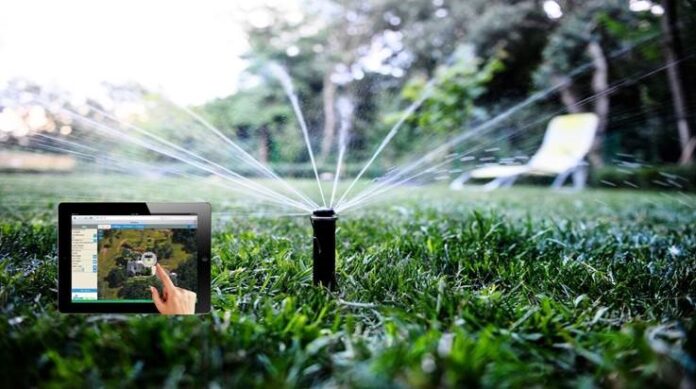The Market for Smart Irrigation Controllers was valued at US$ 350.5 Million in 2022, with an anticipated growth to US$ 1,582.0 Million by the end of 2033. It is estimated that the market for smart irrigation controllers will reach US$ 396.8 Million in 2023 and is expected to grow at a CAGR of 14.8% from 2023 to 2033.
These controllers, representing nearly 35% share in the global smart irrigation controllers market, utilize sensors and climate data to automatically adjust watering plans and amounts based on current weather conditions and soil moisture levels. They are designed to optimize water usage, preserve resources, and reduce water wastage.
Apart from water conservation benefits, smart irrigation controllers offer cost-saving advantages for homeowners, reducing water bills and landscaping maintenance expenses. They also help prevent issues such as plant disease and soil erosion associated with overwatering.
In 2022, the smart irrigation controllers market in North America held the highest market share globally at 25.5%, a position it is expected to maintain throughout the forecast period. Similarly, in the Europe region, the demand for smart irrigation controllers accounted for approximately 19.5% of the market share in 2022, as reported by Persistence Market Research.
Key market growth factors:
Increasing Concerns Over Water Scarcity: Rising awareness about water scarcity and the need for efficient water management solutions drive the adoption of smart irrigation controllers. These systems offer advanced features to optimize water usage, making them essential for sustainable water conservation efforts.
Technological Advancements: Continuous advancements in sensor technology, data analytics, and connectivity solutions enhance the capabilities of smart irrigation controllers. Integration of IoT (Internet of Things) technology allows for real-time monitoring and remote control, improving efficiency and convenience for users.
Government Regulations and Initiatives: Government regulations mandating water conservation measures and incentives promoting the adoption of water-efficient technologies stimulate market growth. Subsidies, rebates, and tax incentives encourage homeowners, businesses, and agricultural sectors to invest in smart irrigation solutions.
Market Restraints
High Initial Investment Costs: The upfront costs associated with purchasing and installing smart irrigation systems can be significant, particularly for larger or more complex landscapes. This initial investment may deter potential customers, especially in regions with limited budgets or where traditional irrigation methods are deeply entrenched.
Lack of Awareness and Education: Limited awareness about the benefits and capabilities of smart irrigation controllers among consumers, landscapers, and agricultural professionals may hinder market growth. Educating stakeholders about the long-term cost savings, water conservation benefits, and environmental advantages of these systems is crucial to overcoming this barrier.
Compatibility and Integration Challenges: Integrating smart irrigation controllers with existing irrigation infrastructure, landscaping systems, and IoT platforms can be complex and challenging. Compatibility issues with different hardware and software components may arise, requiring additional resources and expertise for seamless integration.
Reliance on Internet Connectivity: Smart irrigation controllers often rely on internet connectivity for remote monitoring, data transmission, and software updates. Poor internet connectivity or disruptions in network coverage may compromise the functionality and effectiveness of these systems, particularly in remote or rural areas.
Opportunities
Expansion of IoT and Smart City Initiatives: The proliferation of Internet of Things (IoT) technology and smart city initiatives presents significant opportunities for smart irrigation controllers. Integration with smart city infrastructure and IoT platforms enables real-time monitoring, data analytics, and automated decision-making, enhancing water management efficiency and sustainability.
Emerging Technologies and Innovations: Ongoing advancements in sensor technology, artificial intelligence (AI), machine learning (ML), and predictive analytics offer opportunities to enhance the capabilities of smart irrigation controllers. Integration of drones, satellite imagery, and aerial sensors for precision agriculture and landscape management further expands market potential.
Market Penetration in Developing Regions: Increasing urbanization, population growth, and agricultural modernization in developing regions create opportunities for market penetration. Smart irrigation controllers offer solutions to address water scarcity challenges, improve agricultural productivity, and optimize water usage in urban and rural settings, driving adoption in emerging markets.
Customization and Personalization: Tailoring smart irrigation solutions to specific user needs and preferences presents opportunities for customization and personalization. Offering modular designs, scalable solutions, and customizable features allows manufacturers to cater to diverse customer segments, including residential, commercial, agricultural, and municipal users.
Top Regional Markets
North America: With a significant market share in 2022 and a projected continuation of dominance, North America remains one of the top regional markets for smart irrigation controllers. The region’s focus on water conservation, coupled with advanced technological infrastructure and supportive government policies, drives market growth. High adoption rates among residential, commercial, and agricultural sectors contribute to North America’s leadership position in the global market.
Europe: Europe holds substantial market share in the smart irrigation controllers market, driven by stringent environmental regulations, water scarcity concerns, and sustainable agriculture initiatives. Increasing adoption of precision irrigation techniques, coupled with government incentives promoting water-efficient technologies, fuels market growth in the region. Europe’s emphasis on environmental sustainability and corporate responsibility further boosts demand for smart irrigation solutions across various sectors.
Key Recent Developments
Integration of Artificial Intelligence (AI) and Machine Learning (ML): Manufacturers are increasingly incorporating AI and ML algorithms into smart irrigation controllers to improve predictive analytics, optimize watering schedules, and enhance water management efficiency. These advanced technologies enable controllers to adapt dynamically to changing environmental conditions and user preferences, improving overall performance and user experience.
Expansion of IoT Connectivity: Smart irrigation controllers are evolving to become integral components of IoT ecosystems, enabling seamless connectivity with other smart devices, sensors, and platforms. Integration with IoT platforms allows for remote monitoring, data sharing, and automated control, enhancing operational efficiency and convenience for users.
Enhanced Water Conservation Features: Recent developments focus on enhancing water conservation features in smart irrigation controllers, such as soil moisture sensors, weather-based scheduling, and water flow monitoring. These features enable precise water management, minimize water wastage, and optimize irrigation schedules based on real-time environmental data, contributing to sustainable water usage practices.
Mobile App Integration and User Interface Improvements: Manufacturers are investing in user-friendly mobile applications and intuitive interfaces for smart irrigation controllers, enhancing accessibility and usability for end-users. Mobile app integration allows users to monitor and control irrigation systems remotely, receive alerts and notifications, and access advanced features such as water usage analytics and irrigation history tracking.








